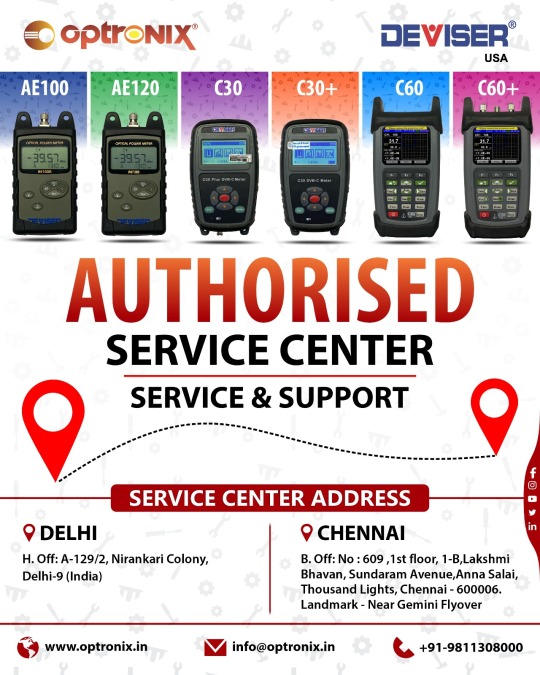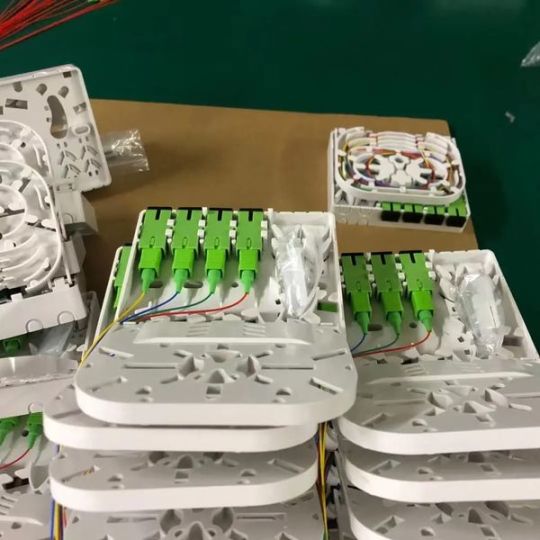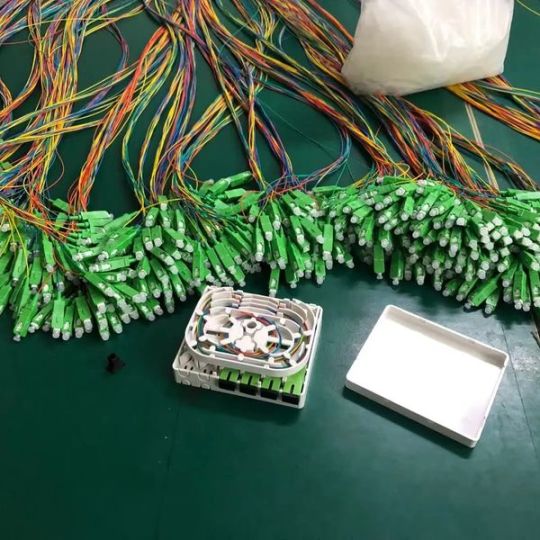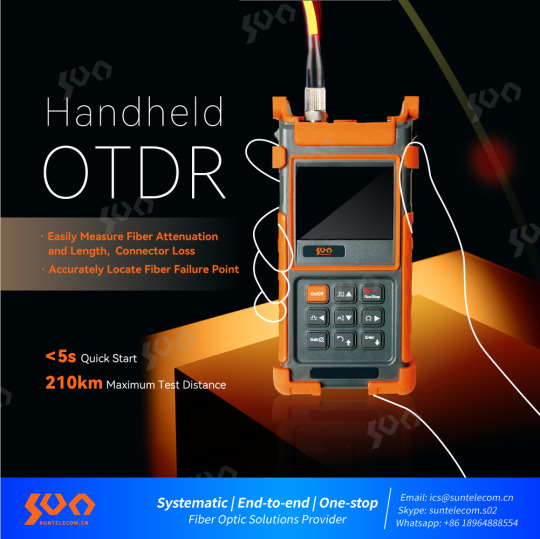#otdr
Text
FCST080620 Mini-Pro OTDR 😍 is apply to FTTx and access network construction and maintenance, to test fiber breakpoint, length, loss and input light automatic detection, automatic test by one key.
The tester is compact with 3.5inch colorful LCD screen, new plastic shell design, shock-proof and drop proof. The tester also combines 8 functions with highly integrated OTDR, Event maps, Stable Light source, Optical power meter, Visual fault locator, cable sequence proofreading, cable length measurement and lighting functions.
It could quick detection of breakpoint, universal connector,600 internal storage, TF card, USB data storage and built-in 4000mAh lithium battery, USB charging. It is a good choice for long term field work.
Watch our video to know more, and feel free to visit our website to check out our solutions of fiber optics at https://www.fcst.com/
#fcst#ftth#fttx#fiberoptics#fiber#fibraoptica#fibra#fcstnews#fcsttime#fibre#fibertothehome#news#pon#otdr#fibertothex#fibernetworks#fibernetwork#telecom#opticalnetwork#optics#fibercable#opticalcable#fibersolutions#aerialcable#aerialcablemanagement#opticalsolutions#fiberproject#opticalfiber
2 notes
·
View notes
Text
Authorized Service Centers for Deviser products

For specific information on authorized service centers for Deviser products like the DVB-C Meter, Signal Level Meter, QAM Analysis, and Optical Meter in Head Office, Delhi, and Branch Office-Chennai, India.
Get more info on our website - https://www.optronix.in/Deviser-service-center.php
1 note
·
View note
Text



FP-019 Features:
Material: ABS plastic
Color: RAL9003 or others
4 SC simplex adapter ports
With Mini. Rotary splice tray for 4fibers splicing
Wall mounted or desktop application
0 notes
Text
Reflectometer's characteristics: sensitivity, accuracy, resolution, working distance
The reflectometer's capabilities in terms of maximum distance and damage detection accuracy are determined by the sensitivity of the amplifier and some other important parameters.
Amplifier sensitivity
The sensitivity of the reflectometer, along with the pulse amplitude, is one of its most essential characteristics. It determines the maximum operating range of the device. It is crucial if you're going to check cables with high signal attenuation.
Technical documentation often skips this parameter or describes it very vaguely. In an ideal scenario, sensitivity should be characterized as the input voltage when the waveform on the instrument display is contained between the top and bottom edges of the screen (i.e., “x mV for full-screen deviation”).
Vertical sensitivity is sometimes measured in decibels. The decibel value is relative and has no meaning unless given a reference level of 0 dB. With this data, the amplifier's sensitivity can be calculated, as each 6 dB step doubles the gain.
Based on the parameters mentioned above—pulse amplitude and amplifier sensitivity—it is possible to calculate the maximum overlapped line attenuation, which also serves as a criterion for assessing the quality of TDR.
The maximum overlapped attenuation (amax) is defined as the line attenuation when the deviation of the vertical beam is at least one-eighth of the full screen. In this case, amax is calculated using the formula:
Amax = 20 lg8 + 20 lg(Upuls/ampl),
- Amax is the maximum attenuation,
- Upuls — pulse amplitude under load Zo,
- Vampl — amplifier sensitivity for full-screen deviation.
It should be mentioned that this method can only be used to compare reflectometers from different manufacturers. It will be impossible to accurately calculate the maximum attenuation overlapped by the reflectometer using this method since the attenuation in metal cables is frequency-dependent. Therefore, different duration pulses will correspond to different Amax values.
The covered method for estimating overlapped attenuation better suits optical TDRs. Optical fibers have frequency-independent attenuation, and therefore, in optical time domain reflectometers (OTDR), the pulse amplitude and sensitivity of the photodetector are usually not taken into account; they are "integral" parameters of the device. A parameter called "dynamic range" is introduced instead, i.e., the insertion loss of the line, at which the signal-to-noise ratio SNR = 1 for a certain duration of the probing pulse. To widen the dynamic range of OTDR, one needs an increase in probing pulse power and the receiver's sensitivity, as well as a very specific set of digital processing algorithms developed by the manufacturer.
Resolution and accuracy

[illustration from viavisolutions.com]
Before discussing the issues related to resolution and accuracy, some basic concepts should be defined.
Display resolution is the interval between two consecutive dots on the screen.
Fault detection resolution is the minimum distance between two consecutive faults to be visible as separate faults on the reflectometer display.
Sampling precision is just the precision with which samples are carried out.
The term "fault localization precision" also speaks for itself.
Fault localization precision
The accuracy of finding the fault in the vast majority of real-world cases is limited by the availability of reliable information for the cable being tested and not by the sampling precision or display resolution of the reflectometer.
Firstly, the pulse propagation coefficient can only be known with an accuracy of a few percent, and on top of that, it is affected by temperature changes. A 1% error in setting the pulse propagation coefficient leads to a 1% error in determining the distance.
Secondly, the limited information on the actual cable route, in turn, limits the user’s ability to find a point along the cable trace marked by the reflectometer as the location of the fault. After all, when tracing a cable to localize the damaged spot, it is nearly impossible to account for all the peculiarities like safety loops, different laying levels, specific terrain, etc.
The resolution of fault detection is also influenced by the pulse duration.
Sampling precision and display resolution
Sampling precision and display resolution are not the same thing. The device may have a high level of sampling accuracy, but its display may have poor resolution, and vice versa.
For example, consider a device with a display resolution of 100 ns. It can detect damage with an accuracy of +100 ns, regardless of the precision of the sampling generation every 100 ns. Similarly, the device may have a display with a very high resolution (say 0.1 ns). Still, if the sampling precision is insufficient, then in this case, it won't be possible to accurately determine the location of the fault. One should remember that when searching for a fault location with a reflectometer, high display resolution, and sampling precision are not always necessary. Even if the reflectometer allows one to find the damage locations within 1 cm, due to the cable routing environment, this level of accuracy is not enough for fault localization; you simply won't be able to find them on a real cable. Thanks to modern clock generation techniques, many OTDRs have sufficient accuracy and resolution of sampling that they can be used in most real-world applications.
A few other important characteristics are tied to the parameters we've covered. We are talking about measurement limits (maximum and minimum distance) and the possibility of scale adjustment.
Maximum distance
Modern technologies make it easy for manufacturers to achieve an almost unlimited range for their devices. However, the sensitivity of the device does not guarantee actual detection of damage at the specified maximum distance. The best way to determine the range of a device is to test it with a cable. The OTDR's distance measurement range and cable length should be gradually increased until a critical point is reached, i.e., a state when the OTDR cannot detect the open end of the cable. When comparing different reflectometers in such a way, it is necessary to use pulses of the same duration.
Minimum distance
Suppose a minimum operating distance of 10 m is specified for one device and 20 m for another. In that case, one shouldn't immediately jump to conclusions. Both devices likely have the same display resolution. Still, the second one has a physically larger display or is less capable of adjusting to the same resolution. Therefore, the key characteristic is the minimum display resolution, not the minimum working distance.
Scaling
Some manufacturers include a scaling function in their reflectometers, allowing them to increase the display's resolution at any distance. In practice, this function has certain limitations when testing long cables. The reflected pulse tends to be "stretched", which leads to losing all advantages in locating the exact point of failure. Typically, only scaling levels no higher than 4× or 8× make practical sense.
1 note
·
View note
Text
Q&A from Sun Telecom:
Guidelines for troubleshooting fiber optic cables.
If you have more questions about fiber optics, share them in the comment section.
Sun Telecom is a Fiber Optic TOTAL Solutions Provider with over 34 years of experience, serving customers from more than 130 countries and regions.
Please contact us if any needs.



#OTDR#fusionsplicer#Telecommunications#FTTH#fibertothehome#fiberoptic#FTTX#CATV#OSP#telecomengineering#survelliance#fiberopticcable#telecomconsult#outsideplan#cabling#computernetworks#smartcity#suntelecom
0 notes
Link
0 notes
Text
#xlhomepromo#wireless#opticalfiber#technology#hargaxlhomebekasi#promoxlhomebekasi#firsmedia#g#fibra#otdr#fibraoptica#fibersplicer#fibreoptic#a#wiring#cablemanagement#broadband#voip#telecommunication#fibersplicing#ethernet#lowvoltagenation#fiberopticcable#fibercable#itsupport#e#telecomunicaciones#fibre#server#fusionsplicer
0 notes
Photo


Mini PRO OTDR, 4.3-inch capacitive touch screen, integrates 12 functions, such as auto OTDR, expert OTDR, event map, OPM, RJ45 cable tracker, and "computer level" file management to meet various test requirements in different occasions
Contact whatsapp: +8618520204997
1 note
·
View note
Text

1 note
·
View note
Text

Various optical cable clamps
Self-produced factory price, welcome to inquire
0 notes
Text
Comprehensive Solutions for OTDR Calibration, Repair, and Rental in Dubai, UAE

In the bustling technological landscape of Dubai, maintaining precision and reliability in fiber optic networks is paramount. Whether it's for telecommunications, data centers, or industrial applications, the performance of Optical Time Domain Reflectometers (OTDRs) plays a critical role. To ensure the seamless operation of these essential devices, businesses and industries rely on comprehensive services such as OTDR calibration, repair, and rental.
OTDR Calibration in Dubai: Accurate measurements are the cornerstone of effective fiber optic testing. OTDR calibration ensures that your equipment meets industry standards and delivers precise results. In Dubai, specialized firms offer calibration services tailored to various OTDR models. These services involve meticulous adjustments and testing procedures conducted by skilled technicians to guarantee the accuracy and reliability of your OTDR readings.
OTDR Repair in Dubai: In the event of malfunction or damage, swift and effective OTDR repair services are crucial to minimizing downtime and restoring operational efficiency. Expert technicians in Dubai possess the knowledge and expertise to diagnose and rectify a wide range of OTDR issues promptly. Whether it's a faulty component, software glitch, or physical damage, reputable repair services offer comprehensive solutions to get your OTDR back up and running smoothly.
OTDR Rental in Dubai: For short-term projects, temporary expansions, or budget constraints, OTDR rental services provide a cost-effective solution without compromising on quality. In Dubai, businesses have access to a diverse fleet of OTDRs available for rent, catering to various specifications and requirements. Whether you need basic testing capabilities or advanced features, rental options offer flexibility and convenience, allowing you to meet project demands without the burden of long-term investment.
Fujikura Calibration and Repair: Fujikura OTDRs are renowned for their reliability and precision, but even the most robust equipment requires regular maintenance and occasional repairs. In Dubai, specialized service providers offer dedicated calibration and repair services specifically for Fujikura OTDRs. With in-depth knowledge of Fujikura products and access to genuine parts, these service centers ensure optimal performance and longevity for your Fujikura OTDR investment.
In conclusion, the availability of comprehensive OTDR calibration, repair, and rental services in Dubai, UAE, underscores the city's commitment to technological excellence and operational efficiency in fiber optic infrastructure. By partnering with reputable service providers, businesses can ensure the reliability, accuracy, and longevity of their OTDR equipment, enabling seamless communication, data transmission, and industrial operations.
#OTDR Repair Dubai#OTDR Calibration Dubai#OTDR Rental Dubai#Fujikura Repair Dubai#Fujikura Calibration Dubai
0 notes
Text
Guidelines for troubleshooting fiber optic cables.

Q&A from Sun Telecom:
Guidelines for troubleshooting fiber optic cables.
If you have more questions about fiber optics, share them in the comment section.
Sun Telecom is a TOTAL Fiber Optic Solutions Provider with over 30 years of experience for customers from more than 130 countries and regions.
Please contact us if any needs.
#Telecommunications#FTTH#fibertothehome#fiberoptic#FTTX#CATV#OSP#telecomengineering#survelliance#fiberopticcable#telecomconsult#outsideplan#cabling#computernetworks#smartcity#suntelecom#OTDR
0 notes
Link

#EXFO#EXFO OTDR#EXFO MaxTester 715B OTDR#exfo maxtester 715b#EXFO MaxTester#OTDR in Bangalore#OTDR#OTDR with iOLM
0 notes
Text
Cutting-Edge Network Testing Equipment in Dubai: Viavi OTDR, Fluke DSX-5000, and Fluke DSX-8000

In the vibrant landscape of Dubai's rapidly advancing technology sector, the demand for efficient and reliable network infrastructure has never been higher. With businesses expanding and embracing digital transformation, ensuring the integrity and performance of networks is paramount. Enter Viavi OTDR, Fluke DSX-5000, and Fluke DSX-8000, three cutting-edge tools that are revolutionizing network testing in Dubai and beyond.
Viavi OTDR in Dubai: Enhancing Network Visibility
Viavi OTDR (Optical Time-Domain Reflectometer) stands as a cornerstone in fiber optic network testing. In Dubai, where fiber optic infrastructure is extensively deployed for high-speed connectivity, in Dubai Viavi OTDR plays a pivotal role in maintaining network health and optimizing performance. With its advanced capabilities, Viavi OTDR enables precise fault location, accurate fiber characterization, and comprehensive troubleshooting, ensuring minimal downtime and maximum efficiency for businesses across Dubai.
Fluke DSX-5000 Dubai: Setting the Standard for Copper Cable Certification
In a city where copper cabling remains prevalent alongside fiber optics, the Fluke DSX-5000 emerges as an indispensable tool for certifying and validating copper network installations. Whether it's in commercial buildings, residential complexes, or data centers, Fluke DSX-5000 ensures that copper cabling meets industry standards for performance and reliability. Its advanced diagnostics capabilities empower technicians in Dubai to identify issues quickly, thus streamlining the deployment and maintenance of copper-based networks.
Fluke DSX-8000 Dubai: Pushing the Boundaries of Network Testing
Dubai's quest for cutting-edge technology finds a perfect match in the Fluke DSX-8000, a state-of-the-art solution for certifying both copper and fiber optic cabling. With its unparalleled speed and accuracy, the DSX-8000 is designed to meet the evolving demands of Dubai's dynamic networking landscape. From verifying network installations to troubleshooting issues with precision, the DSX-8000 equips organizations in Dubai with the tools they need to ensure reliable and high-performance networks.
Conclusion: Elevating Network Testing Standards in Dubai
As Dubai continues to embrace innovation and digital transformation, the importance of robust network infrastructure cannot be overstated. Viavi OTDR, Fluke DSX-5000, and Fluke DSX-8000 stand at the forefront of network testing technology, offering unparalleled reliability, accuracy, and efficiency. Whether it's ensuring the integrity of fiber optic links or certifying copper cabling installations, these tools play a vital role in elevating network testing standards across Dubai's diverse industries.
Incorporating Viavi OTDR, Fluke DSX-5000, and Fluke DSX-8000 into your network testing arsenal is not just a choice; it's a necessity in Dubai's fast-paced digital landscape, where connectivity is king, and downtime is not an option.
0 notes
Text

A mini OTDR is a handheld device used for optical fiber testing and troubleshooting. It is a smaller, more portable version of a full-sized OTDR, and is ideal for testing in difficult-to-reach or hard-to-access areas. A mini OTDR typically has a shorter test range than a full-sized OTDR but is still capable of performing all of the same functions.
#mini#otdr#testing#opticalcable#optic#Christmas_Offer#keypad#easytouse#christmasshopping#christmastime
0 notes